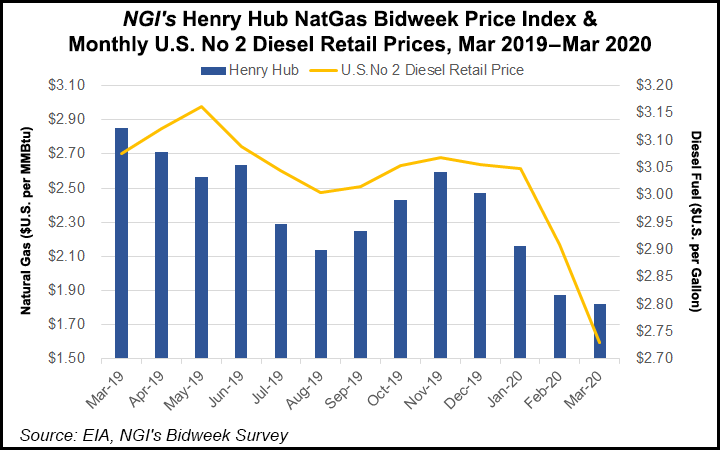NGI The Weekly Gas Market Report | Infrastructure | LNG | NGI All News Access
Alternative Transportation Fuel Sector Stays Revved Up
One part of the U.S. economy that hasn’t been stopped by the pandemic is trucking of goods, and that goes for the alternative transportation fuel that powers many of the fleets.

The fuel cell and hydrogen energy applications are getting more attention from the U.S. Department of Energy (DOE) and a recent report by McKinsey and Co., noting billions of dollars and hundreds of thousands of jobs the hydrogen sector could create by 2030 while providing a lower-carbon energy option. DOE at the end of last year provided more than $160 million in grant funds.
One of the top priorities for the natural gas vehicle (NGV) trade group NGVAmerica is to influence the development of a cleaner trucks initiative at the U.S. Environmental Protection Agency (EPA) to use gas in powering trucking fleets. NGVAmerica also is seeking “regulatory parity” for NGV technology in the EPA and National Highway Traffic Safety Administration’s SAFE rulemaking for light-duty vehicles.
Separately, Mitsubishi Fuso Truck and Bus Corp. plans to begin series production of fuel-cell trucks late this year. It is part of the Daimler Trucks family of companies. Last fall Mitsubishi Fuso introduced its eCenter F-CELL light-duty truck with a range of about 180 miles and a fueling time of 10 minutes.
In California, alternative fuel advocates are pushing clean truck programs at major harbors and for the Interstate Highway 5 north-south corridor, particularly in the energy and agriculture sector-rich San Joaquin Valley. Meanwhile, a San Joaquin Valley air pollution regulatory district program is replacing 2009 vintage or older vehicles that may be NGV-powered trucks or other clean alternatives. Fleet operators can receive up to $200,000/vehicle to change to low and zero-emission trucks.
© 2024 Natural Gas Intelligence. All rights reserved.
ISSN © 1532-1231 | ISSN © 2577-9877 | ISSN © 1532-1266 |
